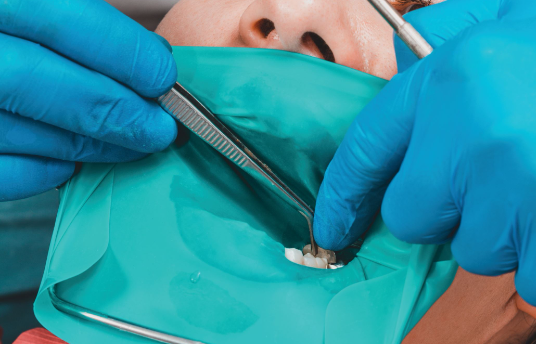Moisture control in Dentistry
 |
Moisture control in Dentistry |
INTRODUCTION:
The oral cavity is intrinsically a wet environment. The presence of oral fluids ( saliva, blood, gingival crevicular fluid and water coolant spray) on the surface of a preparation is likely to:
— Dilute or displace etchant or bonding material.
— Impair the creation of bond between tooth and restoration.
— Interfere with cohesion of successive increment of the restorative material.
— React with restorative material and thus impair its strength or dimensional stability.
— Discolor tooth colored resin restoration eg with blood contamination.
— Prevent the creation of marginal seal where cement lute is employed.
— Contaminate site that should have as low a bacterial load as possible eg pulp exposure and root canal therapy.
For the above reasons, it is necessary to isolate a preparation from moisture, especially when placing a restorative material and in endodontic therapy.
— Rubber dam
— Dilute or displace etchant or bonding material.
— Impair the creation of bond between tooth and restoration.
— Interfere with cohesion of successive increment of the restorative material.
— React with restorative material and thus impair its strength or dimensional stability.
— Discolor tooth colored resin restoration eg with blood contamination.
— Prevent the creation of marginal seal where cement lute is employed.
— Contaminate site that should have as low a bacterial load as possible eg pulp exposure and root canal therapy.
For the above reasons, it is necessary to isolate a preparation from moisture, especially when placing a restorative material and in endodontic therapy.
— Rubber dam
Rubber dam is the most effective method of moisture control and tooth isolation.
Advantages of rubber dam
— Prevent preparation contamination.
— Protect the airway.
— Aids visibility.
— Reduce risk of cross infection from patient to operator.
— Quality of restoration especially resin bonded restoration is significantly improved.
Disadvantages of rubber dam.
— It is an extra procedure with an extra armamentarium.
— It may be time consuming in the inexperience hand.
Armamentarium For using Rubber damn
Rubber dam sheet.
‘’ ‘’ clamp.
’’ ‘’ punch.
‘’ ‘’ forcep
Rubber dam napkin.
Dental floss.
Lubricant.
Rubber dam sheet.
Comes in several sizes, available in several colors
Rubber dam clamp.
Consist of bow, holes and jaws. Type of clamp selected depend on the anchor tooth. There are anterior and posterior clamp which may be winged or wingless.
Rubber dam punch.
For punching holes in the rubber dam through which the isolated teeth will pass.
Rubber dam forceps.
Used for engaging the rubber dam clamp while placing it on the anchor tooth.
Rubber dam frame.
Keep the rubber dam stretched when in place.
Rubber dam napkin.
A gauze placed under the rubber dam to prevent direct contact with the skin
Dental floss.
To test for obstruction to the smooth passage of the rubber dam through the inter proximal area.
Lubricant.
For the underside of the rubber dam for easy passage of teeth through the holes.
Technique of placing a rubber dam
There are many different technique of placing and retaining the rubber dam.
If a clamp is use, 3 different ways may be use.
— Application of rubber dam and clamp simultaneously.
— Rubber dam before the clamp.
— Clamp before the rubber dam.
Technique for inserting a Rubber Damn
— Determine the area to be isolated with the rubber dam. This is usually from the tooth distal to the one to be operated upon to a tooth on the contralateral side. The wider the isolated area the more convenient it is to carry out the operative procedure. — Test the interproximal area with dental floss.
— Select the rubber dam sheet and mark it. Stretch the rubber dam over the teeth to be isolated and mark on the sheet, points at which holes are to be punched.
— Select the clamp.
— Tie dental floss through the holes or bow of selected clamp.
— Apply the rubber dam.
— Protect the patient lip with petroleum jelly. The napkin may be applied between skin and the rubber dam.
— Place the frame stretching the corner of the rubber dam to engage hooks on the frame. Ensure that the rubber dam does not obstruct the nostril.
How to Remove of the rubber dam
It is opposite to that of placing it. Stretch, then cut the septal rubber with a pair of scissor before removing the dam, this will ensure that the recently placed restoration is not fractured or disturbed.
Other methods of moisture control in Dentistry.
— Saliva ejector – use routinely during restorative procedure, it is inadequate on it own. It may be supplemented by any of the other moisture technique.
— Aspirator – very efficient high volume, low vacuum suction device.
— Absorbent system.
cotton wool rolls
cotton wool pellets
Absorbent plaques – sheets of absorbent material which can be adapted to the mucosa, they are more stable than cotton rolls.
NOTE: these can produce painful after effect than cotton burns if they adhere to dry mucosa and are then forcibly removed. When such adherence occur they should be first soaked with water and then gently peeled off.
— Air jet –
usually applied via an air water syringe ( 3 in 1 or triple syringe ).
— Matrix band –
band must be well adapted and wedge to be effective in this role.
— Pharmacological.
These may have systemic medical implication and are very rarely used in routine practice.
— Astringent solution
Applied to control gingival hemorrhage eg
Adrenaline.
— Anti sialogogues – inhibit oral secretion eg atropine.
— Hypnosis – suggested for controlling patients salivary flow rate.


Post a Comment